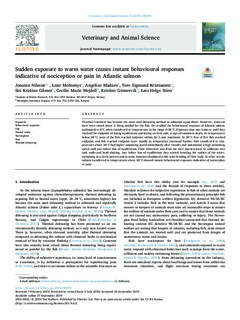| dc.contributor.author | Nilsson, Jonatan | |
| dc.contributor.author | Moltumyr, Lene | |
| dc.contributor.author | Madaro, Angelico | |
| dc.contributor.author | Kristiansen, Tore S | |
| dc.contributor.author | Gåsnes, Siri Kristine | |
| dc.contributor.author | Mejdell, Cecilie Marie | |
| dc.contributor.author | Gismervik, Kristine | |
| dc.contributor.author | Stien, Lars Helge | |
| dc.date.accessioned | 2020-03-05T12:43:56Z | |
| dc.date.available | 2020-03-05T12:43:56Z | |
| dc.date.created | 2019-12-09T14:53:46Z | |
| dc.date.issued | 2019 | |
| dc.identifier.citation | Veterinary and Animal Science. 2019, . | nb_NO |
| dc.identifier.issn | 2451-943X | |
| dc.identifier.uri | http://hdl.handle.net/11250/2645510 | |
| dc.description.abstract | Thermal treatment has become the most used delousing method in salmonid aquaculture. However, concerns have been raised about it being painful for the fish. We studied the behavioural response of Atlantic salmon acclimated to 8°C when transferred to temperatures in the range 0–38°C. Exposure time was 5 min or until they reached the endpoint of losing equilibrium and laying on their side, a sign of imminent death. At temperatures below 28°C, none of the fish reached endpoint within the 5-min maximum. At 28°C four of five fish reached endpoint, and fish reached endpoint more rapidly as temperature increased further. Fish transferred to temperatures above 28°C had higher swimming speed immediately after transfer and maintained a high swimming speed until just before loss of equilibrium. Their behaviour was from the start characterised by collisions into tank walls and head shaking. Just before loss of equilibrium they started breaking the surface of the water, swimming in a circle pattern and in some instances displayed a side-wise bending of their body. In other words, salmon transferred to temperatures above 28°C showed instant behavioural responses indicative of nociception or pain. | nb_NO |
| dc.language.iso | eng | nb_NO |
| dc.title | Sudden exposure to warm water causes Instant behavioural responses indicative of nociception or pain in Atlantic salmon | nb_NO |
| dc.type | Journal article | nb_NO |
| dc.type | Peer reviewed | nb_NO |
| dc.description.version | publishedVersion | nb_NO |
| dc.source.pagenumber | 8 | nb_NO |
| dc.source.volume | 8 | nb_NO |
| dc.source.journal | Veterinary and Animal Science | nb_NO |
| dc.identifier.doi | 10.1016/j.vas.2019.100076 | |
| dc.identifier.cristin | 1758370 | |
| cristin.unitcode | 7431,14,0,0 | |
| cristin.unitname | Dyrevelferd | |
| cristin.ispublished | true | |
| cristin.fulltext | original | |
| cristin.qualitycode | 1 | |
